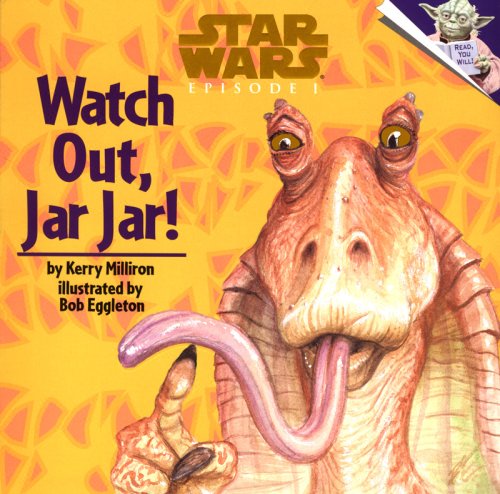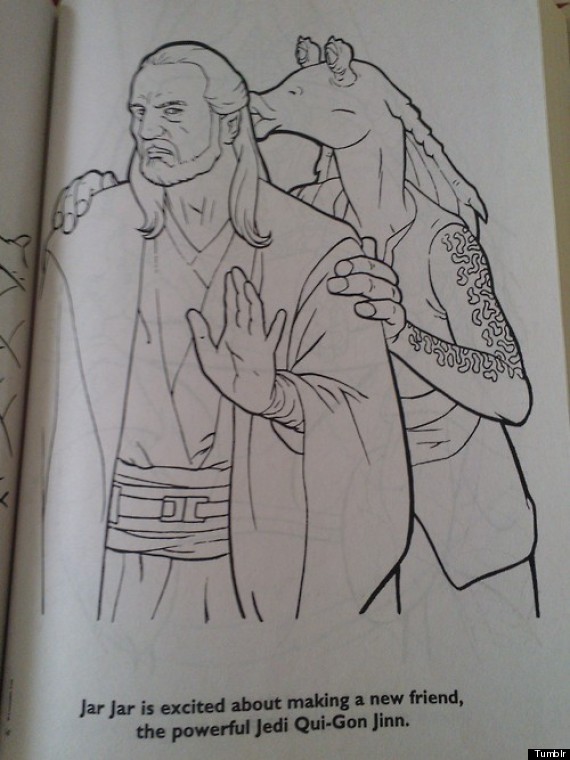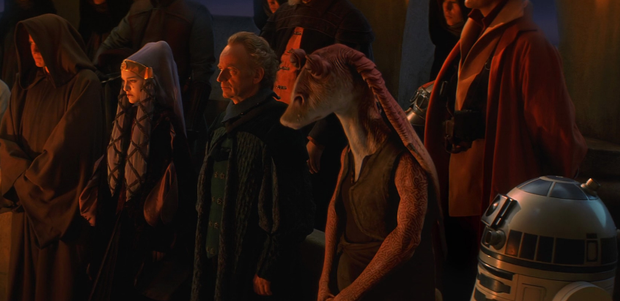Was Jar Jar Binks Really All That Bad?
It’s funny the things that stick out in your mind sometimes. For whatever reason I have a vivid memory of the first time I heard about Jar Jar Binks. It was in an Entertainment Weekly article about The Phantom Menace I believe, and Liam Neeson was predicting that a silly-talking space frog named Jar Jar Binks voiced by Ahmed Best would be a standout among the film’s cast, a fan favorite that audiences wouldn’t be able to stop talking about.
In a Monkey’s Paw scenario, Neeson’s words about everybody talking about Jar Jar Binks came true in the darkest possible fashion. Jar Jar Binks did, in fact, stand out from the rest of the cast in the sense that he was inevitably singled out as an egregious, fatal flaw that all but single-handedly sunk an already dodgy enterprise. Nearly two decades on we still haven’t stopped talking about what an abomination Jar Jar is. We’ve never stopped wondering what the hell George Lucas was thinking when he sprung that abomination upon a world that only ever wanted to love him and his creations. Two decades on Jar Jar Binks remains a controversial figure who angrily demands to be in the conversation when discussing the worst characters ever created.
Jar Jar Binks isn’t just hated the way unpopular characters are hated. He’s hated the way monsters, real and otherwise, are hated. He’s hated the way Hitler and Harvey Weinstein are hated. Jar Jar Binks is hated with a ferocity and intensity that has abated over the years only because it would be impossible to sustain that level of seething, soul-consuming permanently.
I hate to be a hater, but “Talk like Jar Jar Day” has become so commercialized it’s lost all meaning.
Jar Jar Binks is a crowd-pleaser only in the sense that his violent onscreen death would instantly become one of the most popular, crowd-pleasing moments in any Star Wars movie, or, really, any movie ever for that matter. Jar Jar Binks toys served a dual purpose in giving children something to play with and adults something to ritualistically set ablaze in an attempt to exorcise the cursed frog-man from their lives and the world of their favorite movies.
Like Wu-Tang Clan, Jar Jar Binks is for the children. His job was to entertain the younglings with his unique brand of outer space minstrelsy so that a three-movie saga about how a plucky little eight year old hero becomes the most evil man in the universe, to the point where he repeatedly tries to murder his own family, would not be too unbearably grim and child-unfriendly.
That’s a tall order. Remove Jar Jar from the equation and The Phantom Menace becomes a much darker, more serious film about the inevitability of evil and the way good intentions and pragmatism sometimes lead to the worst possible outcome. That could only be an improvement, tonally and otherwise.
Imagine a version of Star Wars where Han, Luke and the gang visit the Janitor planet in the first ten minutes, where they pick up Jim Varney’s Ernest P. Worrell, who then becomes a lead character and one of our heroes without changing in any way and you have a sense of just how dramatically, fascinatingly and violently Jar Jar’s broad physical comedy shenanigans clash with the rest of George Lucas’ bloated, self-important space epic.
A good indication of just how achingly dry and dull The Phantom Menace can be without Jar Jar’s energetic presence to enliven it is provided by the prequel’s fittingly mocked opening crawl.
When the words “A long time ago in a galaxy far, far away….” were followed by “Turmoil has engulfed the Galactic Republic. The taxation of trade routes to outlying star systems is in dispute” fanboys’ penises made rock-hard in tense anticipation of not just a kick-ass new movie but a transcendent spiritual event by John Williams’ rousing main title theme not only became flaccid but actually receded back into their bodies, never to emerge.
“Turmoil has engulfed the Galactic Republic” is an acceptable enough bit of space opera hyperbole but “The taxation of trade routes to outlying star systems is in dispute” all too effectively conveys the film’s alternately dry and overwrought tone, which is closer to “Outer Space C-Span” than “swashbuckling space adventure.”
Jar Jar makes his much-ballyhooed appearance about ten minutes in when Liam Neeson’s Qui-Gon Jinn saves his life. In both the broad outline and specifics, Jar Jar resembles a racist caricature of an African villager or Caribbean islander from a colonialist-minded serial. In a world of adults he’s a simple-minded, innocent child in a man’s body, a bungler with a heart of gold.
Jar Jar speaks in such a heavy dialect that it can be hard to understand what he’s saying. But instead of “Yassuh”, “Nosuh” we get “Mesa” and “Yousa.” Jar Jar’s defining characteristic might just be his cowardice, followed closely by his predilection for buffoonery. He’s a clown but he’s also comically inept. Jar Jar’s race are seen as inferior by people who speak the Queen’s English but the Gungans pride themselves on being fierce warriors.
Almost immediately Jar Jar Binks’ is rescued from oblivion by a white savior. In appreciation, Jar Jar pledges to be Qui-Gon Jinn’s servant but that role shifts to one closer to slave when Qui-Gon Jinn saves Jar Jar a second time when he’s about to be punished by his fellow Gungans. Thankfully Qui-Gon Jinn proves a benevolent master, unlike Watto, the grotesque anti-Semitic caricature who owns Anakin Skywalker (Jake Lloyd). Qui-Gon Jinn helps this simple, backwards soul achieve things he could have never have imagined had he never left his backwards home planet and civilization.
When Jar Jar Binks enters the proceedings he’s like the shot of adrenaline to Uma Thurman’s chest in Pulp Fiction. A perversely sleepy story that takes its tone from Jedi masters so calm and Zen they barely seem awake develops not just a pulse but a manic, nervous, skittering, obnoxious energy.
The Phantom Menace feels like Lucas had an assistant slip everyone else in the cast a Quaalude just before cameras rolled but shot Ahmed Best up with crystal meth to ensure that his energy levels never fall below “pummeling and extreme.”
Jar Jar Binks is a goddamned train wreck. He is voracious and insatiable in his demand for attention. Watching him fill each frame with nonsensical comic flailing and mugging I was reminded of that great moment in Futurama where Zoidberg’s famous silent comedian uncle is directing his comeback movie and insists that just because a scene is dramatic doesn’t mean it can’t be filled with comical business in the background.
But Jar Jar Binks is also far and away the most interesting, compelling and alive element of The Phantom Menace. In a mind-numbing, nap-inducing spectacle where no one seems to have much of a personality, Jar Jar Binks has way, way too much personality.
When I write that nobody in The Phantom Menace has much of a personality, that includes even someone like Obi-Wan Kenobi, whose personality has delighted and fascinated multiple generations of fans when played by Alec Guinness. Ewan McGregor was reportedly drunk throughout the prequels’ filming and, honestly, in this incarnation at least, the surprisingly shitty role of Obi-Wan Kenobi wasn’t worth staying sober for.
There’s an energy to Jar Jar, a vulgarity, a raucous sense of life that almost makes it possible to forgive that everything he brings to the movie is not only terrible but egregiously, unforgettably, almost transcendently awful, ill-conceived and wrong.
The Phantom Menace gives Jar Jar a hero’s journey and a redemptive arc. He begins the movie an outcast, a dunce so blundering and incompetent he has been exiled from his home world for his ineptitude. But white men with British accents take pity on this simple, silly creature, this amphibious man-child and help propel him to a place of accidental but extreme heroism when he bumbles and stumbles and trips all over a battlefield and his sweaty failings somehow result in the destruction of Battle Droids, robotic fighters for evil so flimsy that they shatter if their enemies merely look at them. Seriously, these robots are so shitty and so poorly designed that I started to think of them as the Break-O-Bots.
In another context, Jar Jar Binks failing upwards from outcast to general to accidental war hero might have a satirical element of social commentary. That would require a certain level of comic sophistication and in The Phantom Menace Jar Jar Binks responds to being named General whether he wants the potentially/probably lethal new job or not by doing a full-on flip take. That’s right. Our bumbling, buffoonish, cowardly frog-man doofus is so shocked at being given serious responsibility that he faints dead away.
You’re not wrong, dumb meme!
That’s the level of comedy we’re operating at here: a Bazooka Joe comic strip level. Then again it could be worse and is. Lucas, in all of his wit and wisdom decided to give Jar Jar a sassy and dazzlingly original new catchphrase: a comically indignant cry of “How wude!” Lucas was apparently oblivious to that phrase and sentiment being owned by Full House’s Stephane Tanner, an annoying little girl on a terrible sitcom pretty much everyone in my generation watched religiously pretty much just because it was on. I hesitate to even imagine what discarded Jar Jar catchphrases might be. I bet “Here comes the judge!”, “I am a wild and crazy guy!”, “Do the Bartman!”, “Where’s the Beef?” and “Read my lips: no new taxes” were all on the shortlist.
When Jar Jar tells his new Jedi masters “Ex-squeeze me, but de mostest safest place would be Gunga City” it marked the first time the phrase “Ex-squeeze-me” had been used outside a comedy club with a name like Sir Laughs-A-Lot’s Comedy Castle since 1984.
When Lucas was painstakingly planning his first directorial effort in twenty-two years, a film he knew fans were waiting for with baited breath like it was the goddamn second Coming of Christ or something, he knew he could have cut either the moment when Jar Jar hears, and I would imagine also smells, a big old stinky fart and makes a pained, silly face to demonstrate that he really does not enjoy either the smell, or the bit where Jar Jar steps into a similarly stinky old pile of alien animal doo doo and similarly registers his displeasure in a comically expressive fashion.
Lucas could have cut one, or both, of these gags. Instead, he decided that in order to do justice to the world he had created and that the world fell in love with, he needed both of these scenes. Both of these strong, stinky, all too vivid colors belonged in the massive mural Lucas was crafting with zeroes and ones and terrible ideas and misplaced passion.
But there’s more to The Phantom Menace than stinky space alien scatological humor that co-exists uneasily with an oddly affecting moment where an uncharacteristically somber, non-falling down Jar Jar asks Natalie Portman’s Queen Amidala, “Yousa tinking yousa people ganna die?”
There’s also a whole lot of old-fashioned, antiquated racism not just in the form of Jar Jar’s newfangled Stepin Fetchitisms and Anakin belonging to Watto, a greedy alien with a big hook nose and the voice and badgering, persistent personality of a 1930s Jewish or Italian merchant, but also in the problematic presence of Neimoidians, an evil but not terribly bright alien race that speak in hammy, over-the-top Asian accents out of an old Charlie Chan/Fu Manchu programmer.
The Phantom Menace makes it achingly clear that George Lucas spent the 22 years between Star Wars and The Phantom Menace losing touch with how people talk and think and act and behave. It is a movie born not out of any kind of lived experience but rather compulsive consumption of old movies and TV shows and other forms of antiquated entertainment.
Lucas was among the most backwards-looking of the major filmmakers of the 1970s (only Peter Bogdanovich could match him on that front). When the rest of Hollywood was snorting cocaine off the breasts of sex workers like real artists, Lucas was looking back at his teenaged years with American Graffiti, the sci-fi movies and comic books of the 1930s and 40s with Star Wars and old adventure serials with Raiders of the Lost Ark.
As the millennium drew to a close, Lucas was still drawing inspirations from old movies rather than an outside world that seemed to scare him. So it’s not surprising that his first film as a director in over two decades found him trafficking extensively in old-timey racist stereotypes.
There is no such thing as benign racism. By its very nature, racism is malignant, a poison, a cancer. But there are different gradations of racism. There’s the harsh, brutal, violent racism of Nazis, the KKK and the Alt-Right. But there’s also a softer version that angrily insists that a moderate amount of racism and bigotry is not only acceptable but necessary for society to function.
White people love soft racism because it replaces an honest, deeply challenging and unflattering narrative of personal and institutionalized white racism where the white man represents the colonizer and oppressor with a dishonest but more flattering fantasy of endless caucasian benevolence where the noble white man is a kindly benefactor willing, even eager to share the greatest gift of all—white Christian civilization and all of its accoutrements—with simple, child-like, technologically and intellectually inferior tribes grateful to get a hand up from people smarter and more advanced and civilized and whiter than themselves.
The anger directed towards The Force Awakens and The Last Jedi is primarily a backlash against what fanboys see as the tyranny of identity politics and diversity. But part of it is also undoubtedly rooted in nostalgia for the kinds of stereotypes The Phantom Menace exploits and recycles without examining.
It wasn’t the racism of Jar Jar Binks that seemed to bother fans as much as the vulgarity, the scatology, the stupidity. By the time George Lucas’ space saga roared back to life in 1999, Star Wars fandom had become a form of secular religion. Jar Jar Binks exposed Lucas’ beloved epic not as a New Testament for our times but rather as silly space nonsense for small children.
Lucas himself got to the core of this dissatisfaction when he said that “(The Star Wars) movies are for children but they don't want to admit that... There is a small group of fans that do not like comic sidekicks. They want the films to be tough like The Terminator, and they get very upset and opinionated about anything that has anything to do with being childlike.”
At this point it seems safe to assume that there’s more than just a small group of fans who do not like comic sidekicks. Many people do. It’s a tribute to how seriously fans take Star Wars that the very idea of Jar Jar struck them as heresy.
Still, in a world where Nancy somehow became the hippest, hottest cartoon of 2018 and characters like The Flintstones, Scooby-Doo and Snagglepuss have all been reimagined for gritty, critically acclaimed adult comics/graphic novels I’d like to think we haven’t seen the last of Jar Jar yet.
Jar Jar makes an appearance as a street performer in Chuck Wendig’s Star Wars novel Star Wars: Aftermath: Empire's End. I haven't read the novel so I don’t know how big or small his appearance is but I’d like to think that in the right hands, Jar Jar Binks could be reborn as a character of tremendous depth and pathos.
Jar Jar Binks did not cut it as a comic sidekick or lowbrow comic relief. But he might just be perfect for tragedy. That’d be appropriate, since everything about his sad, brief life as the most unpopular, least loved would-be fan favorite of all time is tragic, including the fact that Michael Jackson desperately wanted to play the character. It’s probably for the best for everyone that that did not happen because, let’s face it, Jackson as Jar Jar could be a little embarrassing.
Did you enjoy this article? Then you will LOVE the Flaming Garbage Fire Edition of The Joy of Trash because it includes this piece and 51 more just like it!
Buy The Joy of Trash: Flaming Garbage Fire Extended Edition at https://www.nathanrabin.com/shop and get a free, signed "Weird Al” Yankovic-themed coloring book for free! Just 18.75, shipping and taxes included! Or, for just 25 dollars, you can get a hardcover “Joy of Positivity 2: The New Batch” edition signed (by Felipe and myself) and numbered (to 50) copy with a hand-written recommendation from me within its pages. It’s truly a one-of-a-kind collectible!
Or you can buy The Joy of Trash from Amazon at https://www.amazon.com/Joy-Trash-Nathan-Definitive-Everything/dp/B09NR9NTB4/ref=tmm_pap_swatch_0?_encoding=UTF8&qid=&sr= but why would you want to do that?
Check out my new Substack at https://nathanrabin.substack.com/
And we would love it if you would pledge to the site’s Patreon as well. https://www.patreon.com/nathanrabinshappyplace















